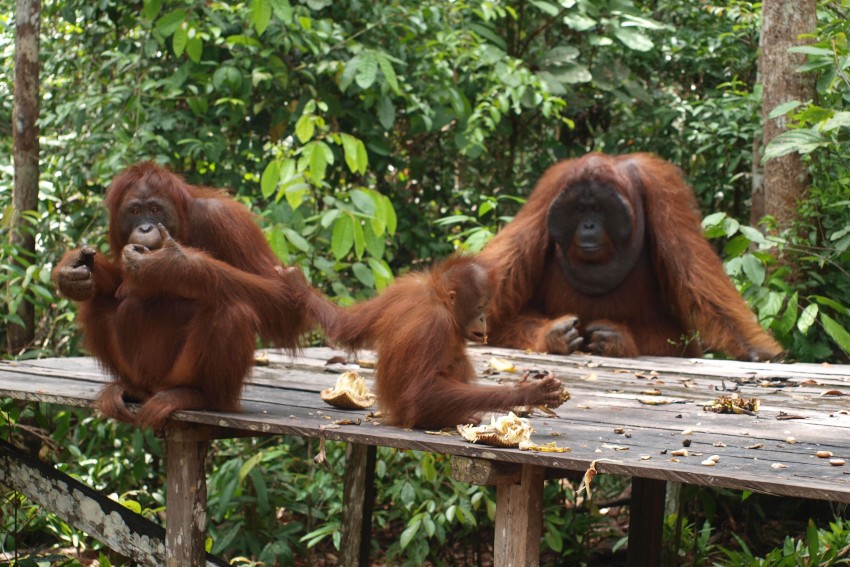Bali, Borobudur, Borneo and beyond

I won the lottery. The sibling lottery that is, to see who would accompany our mother on a luxury expedition by sea around Indonesia, in anticipation of her 90th birthday.
Mum had been contemplating such a cruise for some time, and Australia-based Orion Expedition Cruises came highly recommended by Adelaide friends, for their West Australian Kimberley Coast voyages in particular. The lure of the exotic won out though, and we chose a new Orion itinerary that would take us from Benoa, Bali, to Semarang, Java, (jumping-off port for the World Heritage-listed Borobodur and Prambanan temple compounds), and to Camp Leakey, Borneo to mix it with orphaned and wild orangutans, gibbons, proboscis monkeys, macaques and numerous other intriguing rainforest dwellers. From there we would sail on to Pare Pare, Sulawesi, and overnight in the remote highland region of Tana Toraja, home to the distinctive Tongkonan architecture and megalithic tombs of the Torajan people. The original itinerary included a final island stopover to visit pre-historic Komodo dragons, but that leg was cancelled ahead of departure, when a landslide on one of the road routes thwarted an already jam-packed itinerary. Founded in early 2004 by Australian Business Woman of the Year winner, Sarina Bratton, Orion are pioneers in offering the increasingly fashionable hybrid of combining expedition cruising to remote and unusual destinations with elevated levels of comfort, service and cuisine. With a crew and staff of over 70, and only three quarters of the 100-maximum passenger load on board, we enjoyed an incredible one-on-one staff to passenger ratio on Orion II, a slick, newly refurbished vessel that had only recently joined the Orion fleet. This ensured a level of service appropriate to the stylish, spacious and sophisticated ambience on board. Being a cruise ‘virgin’, I had little idea of what to expect as Mum and I embarked. I suppose I envisaged a lazy 10 days’ lounging on deck or in the library, buried in a book, surrounded by other octogenarians, and accompanying Mum on the occasional onshore diversion. I did know that the food would be great, as Orion’s menus are designed by Serge Dansereau, fabled father of the fresh food movement, and founder of Balmain’s legendary Bavers’ Pavillion. I was therefore somewhat unprepared for the depth and intensity of the cruise’s educational program, and the grueling nature of its onshore agendas. Days at sea were spent attending back-to-back lectures delivered by a variety of passionate on-board experts, so that each land excursion became a thoroughly informed experience. We learnt about Hindu, Buddhist, Islamic and Christian cultural influences over the centuries and witnessed first hand the catastrophic consequences for precious orangutan habitat, and global carbon emissions generally, of the rapid ongoing conversion of rainforest to palm oil plantations. (Look out for ‘palm oil friendly’ labeling on your nearest supermarket shelf. The stuff is as ubiquitous as that other rainforest devourer, the soybean, so I was happy to learn that my beloved Golden North ice cream is palm oil free.) When crossing the Wallis Line, which divides the Indonesian archipelago into two distinctive ecological zones, we were informed about the biogeographic history of the region, and the role of maverick British naturalist Alfred Russell Wallace, in proposing a theory of evolution and natural selection independently of Charles Darwin. In Borneo and Sulawesi we observed ancient animist rituals and heard about recent frightening massacres brought on by the disastrous forced migration policies of the Indonesian government. 89-year-old Mum took all the dawn disembarkations, day-long bus excursions, treks through temples, towns, forests and rice paddies, and late-evening returns in her stride. She only missed one outing, when the severity of the early morning equatorial sun on deck at breakfast caused her to pull out of a river day trip in a sun-exposed Zodiac inflatable raft. She’d already spent a day with orphaned orangutangs in sweltering jungle heat at an orangutan veterinary and quarantine facility the day before, so felt she could let go of the variation-on-a-theme experience at the Camp Leakey rehabilitation and release station, accessible only by river, in Borneo’s Tanjung Putting National Park. Her decision proved prescient, as our group’s klotok, (a traditional wooden river boat used for the return journey), gave up the ghost around sunset, necessitating an emergency rescue operation to get us back in time for the late-night sailing to our next destination. The highlands of southern Sulawesi were the highlight of the trip. They also provided Mum with her most memorable experience. As eldest passenger she was invited to lead our procession across rice paddies and up a steep incline past dozens of slaughtered buffalo, to an extraordinary Torajan funeral ceremony, following crewmembers bearing aloft the gift of a squealing live pig. While this particular itinerary could do with some refinement to alleviate its rather taxing timetable, there is no doubt that Orion have used their experience bringing passengers into Australia’s pristine and sensitive wilderness areas to successfully develop a marine tourism blueprint that now offers a sustainable, eco-sensitive international benchmark.